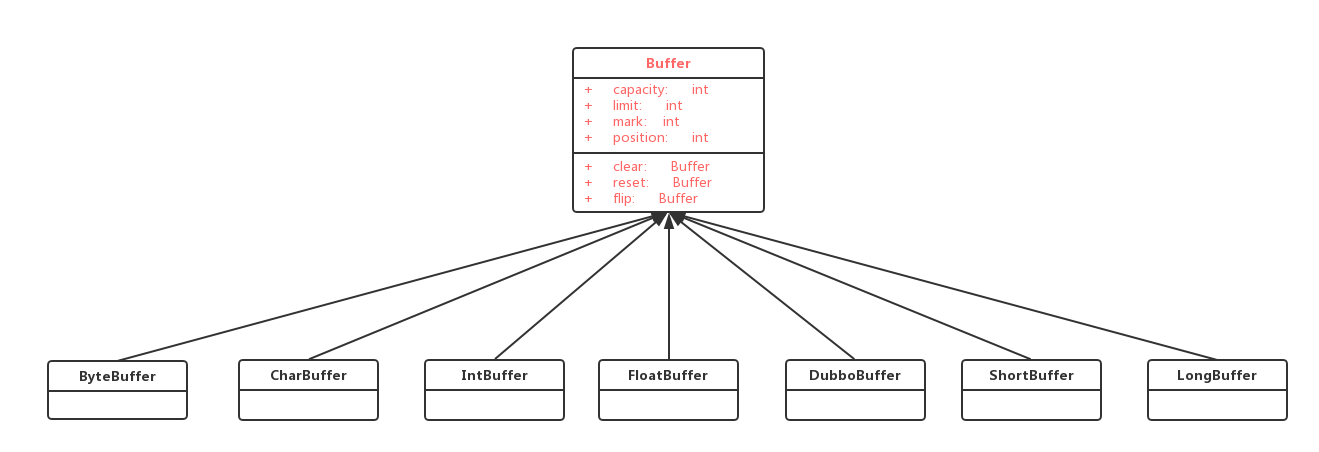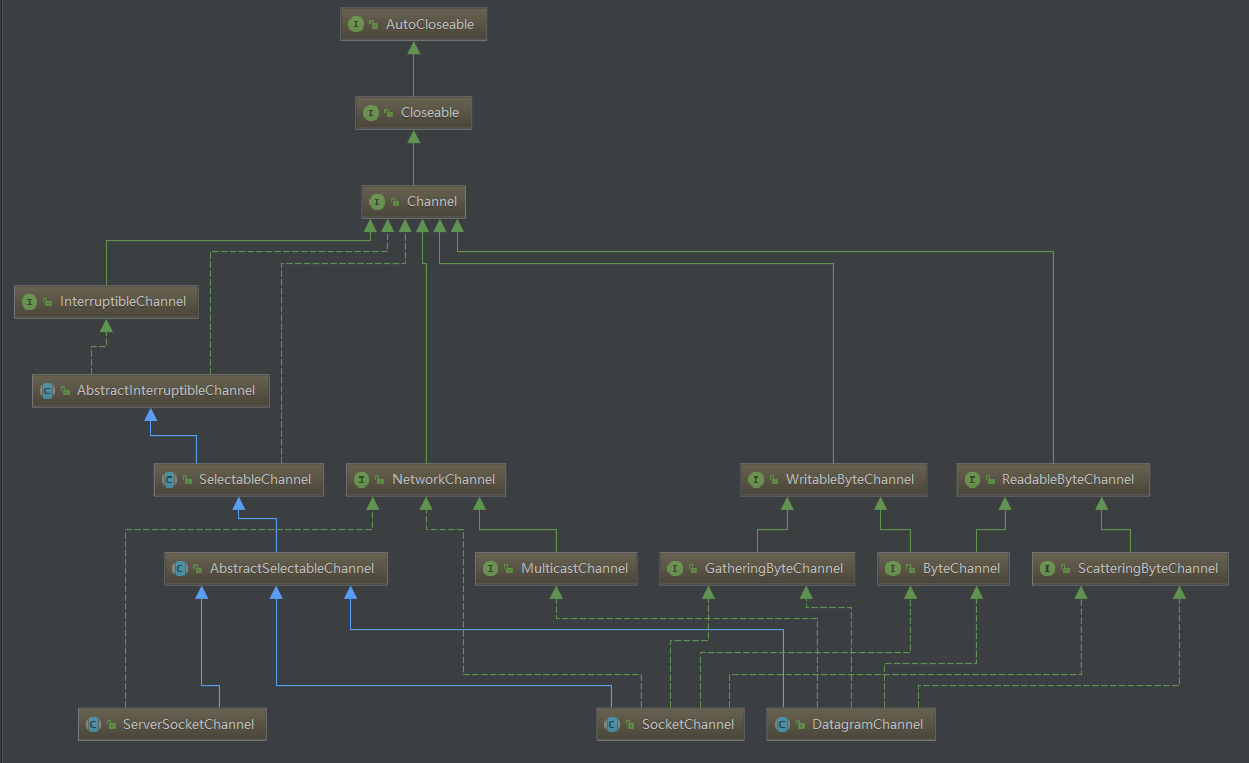作者:唐亚峰 | 出自:唐亚峰博客
在上一篇文章中介绍了传统I/O编程的弊端,本章将概述
NIO的由来和和一些基本概念……
类库简介
2002年的时候,Sum公司推出了JDK1.4并且新增了NIO的类库,弥补了原来同步阻塞I/O带来的不足,官方称之为New I/O,寓意指新的I/O编程模型,但是由于旧版的Block I/O在民间更喜欢称它为Non Block I/O(非阻塞I/O)编程模型,在NIO的类库中,将原本java.net.Socket 以及 java.net.ServerSocket 分别升级成 java.nio.SocketChannel 和 java.nio.ServerSocketChannel,它们都支持阻塞与非阻塞模式,前者性能与可靠性较差,后者却恰恰相反,在开发过程中可以选取适合自己的模式,一般来说,低负载、低并发的应用程序可以选择同步阻塞IO以降低编程复杂度。但是对于高负载、高并发的网络应用,需要使用NIO的非阻塞模式进行开发….
Buffer
Buffer是一个含读写数据操的作对象,在NIO库中,所有的对象都是用缓冲处理的,读写数据操作时都是通过缓冲区来处理,实际上它是一个数组,但通常它是一个字节数组(ByteBuffer),也可以使用其它种类的数组,但是一个缓冲区不仅仅是一个数组,缓冲区提供了对数据结构化访问及维护读写位置(limit)等信息…

Channel
Channel是一个全双工的通道(同时支持双向传输,在BIO中都是单向流,即InputStream 和 OutputStream),因为是双向的,所以它可以更好的映射底层操作系统的API,特别是在UNIX网络编程模型中,底层操作系统的通道都是双全工的,同时支持读写…

Selector
Selector是NIO中的基础,对NIO编程至关重要,它是一个多路复用器,提供选择已经准备就绪的任务功能,会不断轮训注册在它上面的Channel,如果某个Channel上面有新的TCP请求接入,它就会处于就绪状态,供Selector轮训出来,然后可与通过SelectorKey获取就绪的Channel集合,从而进行I/O操作…
异步非阻塞服务端实现

注意事项
- 与Selector 使用的 Channel 必须处于非阻塞模式
- 每次使用Selector时应该先判断下Selector是否已经被关闭,否则容易出现java.nio.channels.ClosedSelectorException错误
public static void main(String[] args) {
int port = 4040;
MultiplexerTimeServer timeServer = new MultiplexerTimeServer(port);
new Thread(timeServer,"NIO-MultiplexerTimeServer-1").start();
}
通过
TimeServer的时序图,我们来看下实现的异步非阻塞的TimeServer代码
public class MultiplexerTimeServer implements Runnable {
private Selector selector;
private ServerSocketChannel serverSocketChannel;
public MultiplexerTimeServer(int port) {
try {
selector = Selector.open();//打开多路复用器
serverSocketChannel = ServerSocketChannel.open();//打开ServerSocket通道
serverSocketChannel.configureBlocking(false);//设置异步非阻塞模式,与Selector使用 Channel 必须处于非阻塞模式
serverSocketChannel.bind(new InetSocketAddress(port), 1024);//绑定端口为4040并且初始化系统资源位1024个
serverSocketChannel.register(selector, SelectionKey.OP_ACCEPT);//将Channel管道注册到Selector中去,监听OP_ACCEPT操作
System.out.println("TimeServer启动成功,当前监听的端口 : " + port);
} catch (IOException e) {
e.printStackTrace();
System.exit(1);//如果初始化失败,退出
}
}
@Override
public void run() {
while (true) {
try {
//int select = this.selector.select(1000); 1S唤醒一次,加休眠时间则可以不要if(select > 0 )
if (!selector.isOpen()) {
System.out.println("selector is closed");
break;
}
int select = selector.select();
if (select > 0) {
Set<SelectionKey> selectionKeys = this.selector.selectedKeys();
Iterator<SelectionKey> it = selectionKeys.iterator();
while (it.hasNext()) {
SelectionKey key = it.next();
it.remove();//删掉处理过的key
try {
handleInput(key);
} catch (Exception e) {
if (key != null) {
key.cancel();
if (key.channel() != null)
key.channel().close();
}
}
}
}
} catch (IOException e) {
e.printStackTrace();
}
}
}
private void handleInput(SelectionKey key) throws IOException {
if (key.isValid()) {//处理新接入的请求消息
if (key.isAcceptable()) {
SocketChannel accept = ((ServerSocketChannel) key.channel()).accept();
accept.configureBlocking(false);
//添加新的连接到selector中
accept.register(this.selector, SelectionKey.OP_READ);
}
if (key.isReadable()) {//读取数据
SocketChannel sc = (SocketChannel) key.channel();
ByteBuffer buffer = ByteBuffer.allocate(1024);//一次最多读取1024
int read = sc.read(buffer);
if (read > 0) {
buffer.flip();//反转缓冲区
byte[] bytes = new byte[buffer.remaining()];
buffer.get(bytes);
String msg = new String(bytes, "UTF-8");
System.out.println("TimeServer 接收到的消息 :" + msg);
doWrite(sc, "挽歌君老帅了...");
} else if (read < 0) {
key.cancel();
sc.close();
} else {
//读取0个字节忽略
}
}
}
}
private void doWrite(SocketChannel channel, String resp) throws IOException {
if (resp != null && resp.trim().length() > 0) {
byte[] bytes = resp.getBytes();
ByteBuffer writeBuffer = ByteBuffer.allocate(bytes.length);//根据字节大小创建一个Buffer
writeBuffer.put(bytes);//将字节数组复制到缓冲区
writeBuffer.flip();//反转缓冲区
channel.write(writeBuffer);//调用管道API将数据写出
}
}
}
- select()阻塞到至少有一个通道在你注册的事件上就绪了。
- select(long timeout)和select()一样,除了最长会阻塞timeout毫秒(参数)。
- selectNow()不会阻塞,不管什么通道就绪都立刻返回(译者注:此方法执行非阻塞的选择操作。如果自从前一次选择操作后,没有通道变成可选择的,则此方法直接返回零。)。
- select()方法返回的int值表示有多少通道已经就绪。亦即,自上次调用select()方法后有多少通道变成就绪状态。
- 如果调用select()方法,因为有一个通道变成就绪状态,返回了1,若再次调用select()方法,如果另一个通道就绪了,它会再次返回1。
- 如果对第一个就绪的channel没有做任何操作,现在就有两个就绪的通道,但在每次select()方法调用之间,只有一个通道就绪了。
- 调用Selector.wakeup()方法即可。阻塞在select()方法上的线程会立马返回。
客户端实现

public class TimeClient {
public static void main(String[] args) {
int port = 4040;
new Thread(new TimeClientHandler("127.0.0.1",port),"NIO-MultiplexerTimeServer-1").start();
}
}
与之前的
TimeClient不同的是这次通过TimeClientHandler线程来处理异步连接和读写操作
public class TimeClientHandler implements Runnable {
private String host;
private int port;
private Selector selector;
private SocketChannel socketChannel;
private volatile boolean stop;
public TimeClientHandler(String host, int port) {
this.host = host == null ? "127.0.0.1" : host;
this.port = port;
try {
selector = Selector.open();//打开连接
socketChannel = SocketChannel.open();//打开连接
//TODO 该处存在一个小BUG,第一条数据会丢失
//TODO 如果该处设为true阻塞,则客户端会报错,应该是本人写法还存在点问题
socketChannel.configureBlocking(false);
} catch (IOException e) {
e.printStackTrace();
System.exit(1);//异常情况断开连接
}
}
@Override
public void run() {
try {
doConnect();
} catch (Exception e) {
e.printStackTrace();
System.exit(1);//异常情况断开连接
}
while (!stop) {
try {
if (selector.select() > 0) {
Set<SelectionKey> selectionKeys = selector.selectedKeys();
Iterator<SelectionKey> iterator = selectionKeys.iterator();
while (iterator.hasNext()) {
SelectionKey selectionKey = iterator.next();
iterator.remove();
try {
handleInput(selectionKey);
} catch (Exception e) {
if (selectionKey != null) {
selectionKey.cancel();
if (selectionKey.channel() != null) {
selectionKey.channel().close();
}
}
}
}
}
} catch (IOException e) {
System.exit(1);
}
}
if (selector != null) {
try {
selector.close();
} catch (IOException e) {
e.printStackTrace();
}
}
}
private void handleInput(SelectionKey key) throws IOException {
if (key.isValid()) {//验证这个key是否有效
SocketChannel channel = (SocketChannel) key.channel();
if (key.isConnectable()) {//判断SocketChannel是否处于连接状态
if (channel.finishConnect()) {//判断 SocketChannel 是否连接成功
channel.register(this.selector, SelectionKey.OP_READ);//连接成功则注册OP_READ事件到Selector选择器中
doWrite(channel);
} else {
System.exit(1);
}
ByteBuffer readBuffer = ByteBuffer.allocate(1024);//创建读取所需Buffer
int read = channel.read(readBuffer);
if (read > 0) {
readBuffer.flip();//反转缓冲区
byte[] bytes = new byte[readBuffer.remaining()];
readBuffer.get(bytes);
String msg = new String(bytes, "UTF-8");
System.out.println("TimeClient 接收到的消息:" + msg);
}
this.stop = true;//如果接收完毕退出循环
}
}
}
private void doConnect() throws IOException {
if (socketChannel.connect(new InetSocketAddress(host, port))) {
socketChannel.register(this.selector, SelectionKey.OP_READ);
doWrite(socketChannel);
} else {
socketChannel.register(this.selector, SelectionKey.OP_CONNECT);//向Reactor线程的Selector注册OP_CONNECT事件
}
}
private void doWrite(SocketChannel channel) throws IOException {
byte[] req = "挽歌君帅不帅".getBytes();
ByteBuffer buffer = ByteBuffer.allocate(req.length);
buffer.put(req);//将字节数组复制到缓冲区
buffer.flip();//反转缓冲区
channel.write(buffer);
if (!buffer.hasRemaining()) {
System.out.println("消息发送成功");
}
}
}
测试
分别启动TimeServer 和 TimeClient
服务端
TimeServer 接收到的消息 :挽歌君帅不帅
客户端
消息发送成功
TimeClient 接收到的消息:挽歌君老帅了...
– 遗留问题
1、 该处存在一个小BUG,客户端向服务端发送请求,服务端第一次数据回写客户端未接收到,但是后续的请求都有接收到,这应该是异步请求导致;
– 说点什么
参考:Netty权威指南
全文代码:https://git.oschina.net/battcn/battcn-netty/tree/master/Chapter2-1/battcn-netty-nio